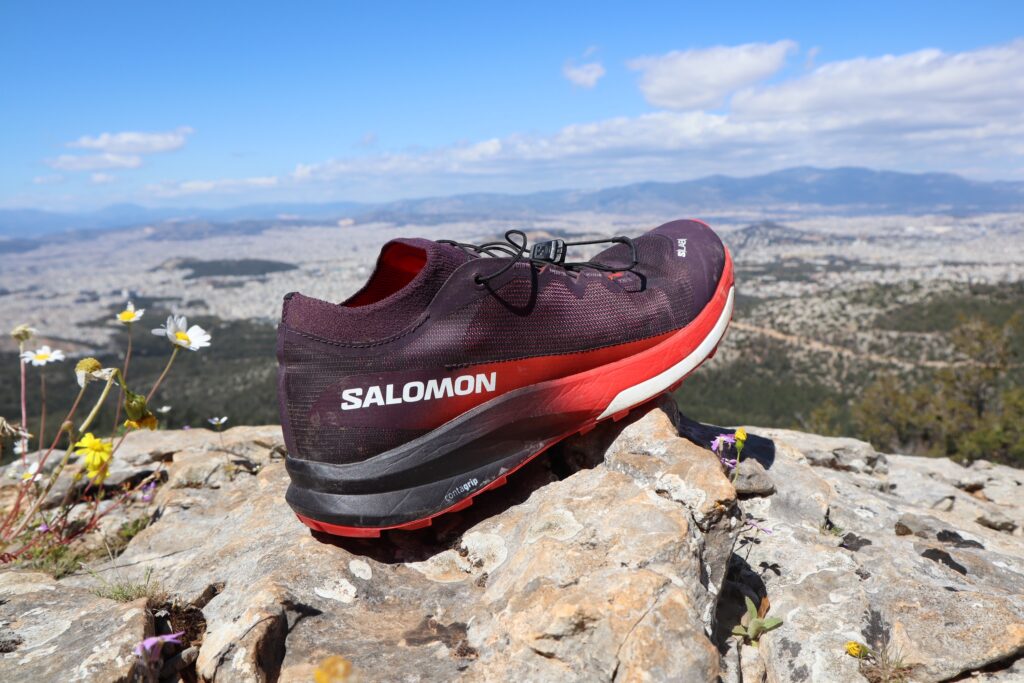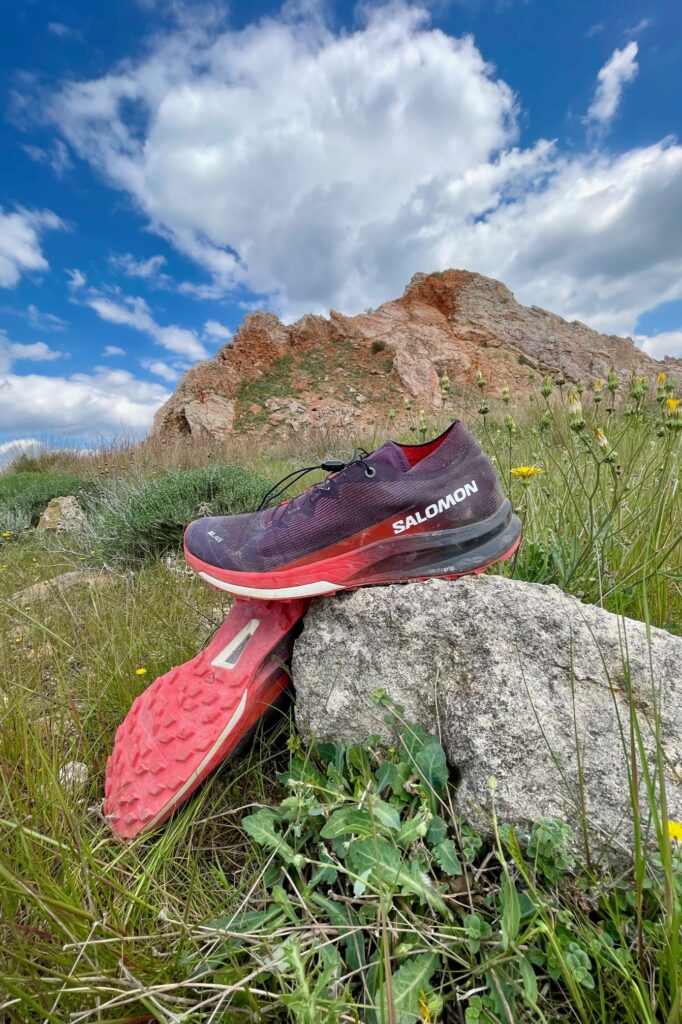Salomon S/Lab Ultra – Test and Review
"The grip on dry rock was fantastic, making both scrambling and pacing downhill at speed feel safe."
The original Salomon S/LAB Ultra 3 model was released a couple of years ago, with endurance, speed and racing on mixed terrain in mind. It was successful in the trail running community based on my unscientific survey of checking out what others wear when I hit the trails, especially when it’s for racing. How different is Salomon’s recent update? The fact they kept the same name (just adding a ‘v2’ on the box label) gives a hint.
At first sight the differences are minimal. The midsole and outsole are the same. The upper was updated with a slightly lighter, breathable material (Matryx), said to lighten the shoes by about 7%, but my weighing both old and updated versions on a kitchen scale showed the same numbers. Although the colour name (and only colour scheme available) was updated from ‘maverick/racing red/maverick’ to ‘plum perfect/fiery red/white’, it looks the same. It will be difficult to tell who is racing with what in the future. The Salomon logo printed with a different font is the practical cue helping telling them apart.

Despite having the impression that I had the same old model at hand, I was excited going out testing it. I had a great experience with the original version, and had been looking for the perfect shoe to go racing on Alpine trails over the coming months. This one could be a strong candidate for it, Courtney Dauwalter had been a great ambassador wearing them when smashing her races, therefore I might have a good chance too – not at smashing races, but at having the best experience at it.
These shoes are hard to put on at first. They are stiff and the integrated gaiter is tight. That did not loosen over time and the experience of putting them on did not get any easier after a few runs. I see it as a good sign, showing the shoe fit will remain strong and the tight gaiter will continue keeping debris out even after a while. Perhaps adding a loop at the back of the shoe could help with putting them on but this would eventually add unnecessary weight. It’s a small price to pay, because once on the feet, they are comfortable and fit like a glove (or should I say, a sock).
The shoes are on the narrow side and true to size, albeit with a generous toe box. My heels were well locked and my feet never rubbed. The inner and upper are padded, also where Salomon’s Quicklace lacing system has to be tightened, and I did not experience any unwanted pressure on my feet. The Quicklace is a great alternative to traditional laces. It’s solid, easy to adjust, and holds well even under most conditions, also after many hours running. The ‘pocket lace’ to store Quicklace buckle is roomy enough and easy to use on this model, unlike with some other Salomon ones where I had struggled a bit, eventually opting to keep the lace out.
The upper mesh is light and flexible and does not ‘stab’ the foot where it creases – something I unfortunately experienced with other shoes using rigid synthetic uppers. The shoe feels firm without being rigid. The polyurethane midsole is relatively thick (at 21mm to 29mm thickness and 8mm drop), provides some cushioning, responsiveness and bounce, without feeling overly generous about it however. It’s a stable shoe, and my feet felt the connection to the ground. Although this is great when on trails, this made me wonder how comfortable they would be when running on long tarmac sections during ultras. Overall, I did not experience any pain, felt friction, or got any blister when testing them on outings of upwards of 4-5 hours. If these shoes behave like the original S/LAB Ultra 3, I know it should be also the case for longer runs.
I tested the shoes in two fairly different environments. First, in the Surrey hills on forested trails and through many different varieties of mud. It had rained for the past few weeks, and was still raining when I was out running. I then tested the shoes further in the hills and mountains around Athens, on dry rocky trails, also including forest paths, in sunny weather. Running in Greece ended up being a significantly more pleasant experience, and not just because of the better weather.
The time spent in the Surrey hills was disappointing due to insufficient grip and traction on mud and on wet ground more generally. This could be due a combination of the shoe lugs at 4mm not being deep enough, of the lug pattern, or of the Contragrip material used in the outsole not performing well when wet. Climbing a grassy or muddy slope was a struggle even at low gradient, running (bouncing) up was ineffective without slowing down to walking pace given the lack of traction. I didn’t feel confident when running downhill either, with the shoes sliding too easily on mud and slipping on wet rock. This would likely rule these shoes out for racing when it gets wet and muddy, with Salomon Speedcross or a similar model being a better alternative. On the positive side, I noted that despite all the mud I would run on, that mud would not stick too easily to the shoes, and would not build up to a layer worsening grip and traction over time like I had experiences with other shoes. The shoes were easy to clean post-run, with the upper drying fast, and not smelling of damp over the following days.

The Athens hills experience was bliss in comparison. I went along dry, steep, often rocky, technical paths. I enjoyed a few great rides with increasing confidence given the shoes were responding well the more demanding I was and the harder I pushed them. The amount of midsole cushioning felt right, including in the forefoot section making running uphill feel easier. Traction was great unlike what I had experienced in Surrey. The grip on dry rock was fantastic, making both scrambling and pacing downhill at speed feel safe. The shoes were light and reactive. I could feel the ground underfoot but had enough protection against sharp rocks – the midsole seems to include a rock plate that can be seen through a small gap in the middle the sole. It was a pair of shoes I could easily forget I had on. I had taken another pair of well-worn and tested trail shoes with me in Greece, but did not have a great time with them and ended up using the Salomon S/LAB Ultra 3 on all my other runs, not just for more testing but because I enjoyed them. It included running around town, on tarmac and on uneven but slippery, polished marble paths around the Acropolis. Again, the grip was good and the ride overall was comfortable.
It’s a pair of shoes I would recommend if the weather keeps trails dry, but I would think twice taking them in muddy conditions and would likely rule them out in boggy ones. I will take them with me when racing in the Alps this summer. They are high performance and felt durable but are not cheap, therefore it might be worth looking for a pair of the previous but similar S/LAB Ultra 3 iteration.
Review by Julien Cazorla









